Corporate Accounting and Reporting: Impairment Loss Analysis, Finance
VerifiedAdded on 2023/06/06
|6
|1457
|361
Homework Assignment
AI Summary
This document presents a comprehensive solution to a corporate accounting assignment focusing on impairment analysis and financial reporting. The assignment addresses the basic principles of asset impairment, emphasizing that assets should not be recorded above their recoverable amount, which is the higher of value in use and fair value less costs. It details the comparison between carrying amount and recoverable amount, the calculation and treatment of impairment loss, and the specific handling of goodwill and intangible assets. The solution includes a breakdown of impairment indicators, both external and internal, and the disclosure requirements for companies. Part B of the solution provides a practical application of the concepts, calculating the total impairment loss for a cash generating unit, allocating the loss among various assets including goodwill, and providing the corresponding journal entries. The document references relevant accounting literature and emphasizes the importance of professional knowledge and skills in business forecasting and modeling within the finance department.
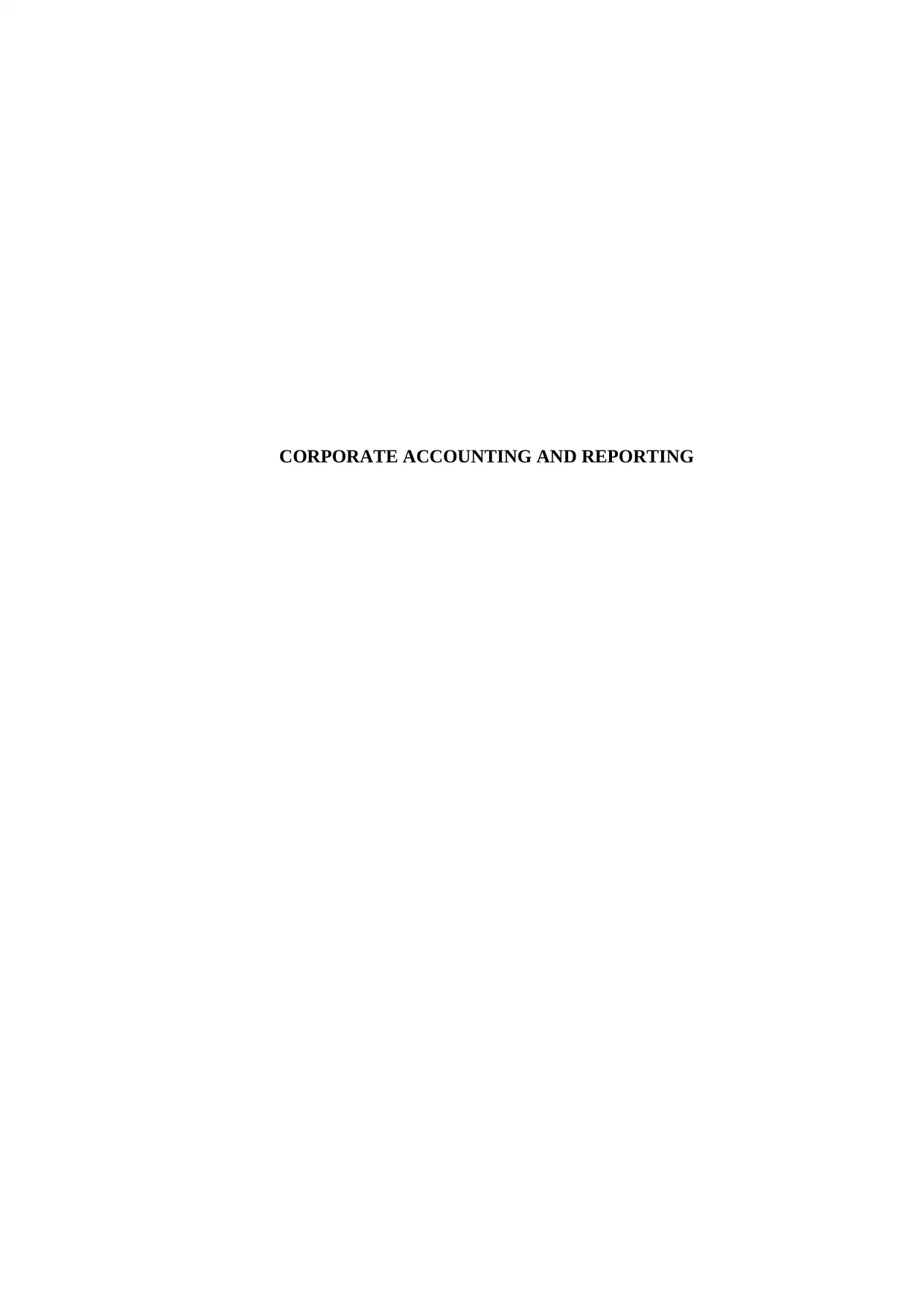
CORPORATE ACCOUNTING AND REPORTING
Paraphrase This Document
Need a fresh take? Get an instant paraphrase of this document with our AI Paraphraser
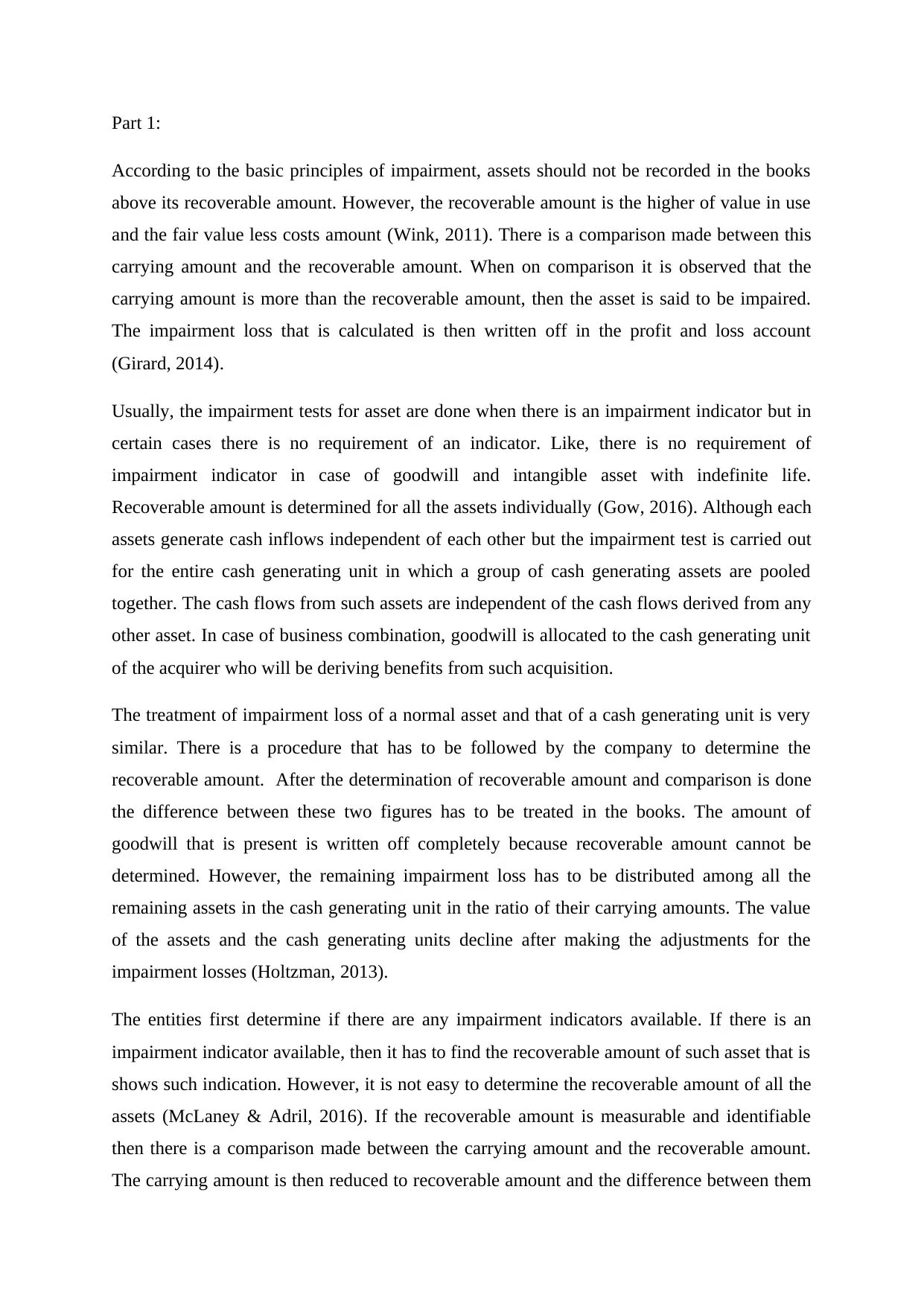
Part 1:
According to the basic principles of impairment, assets should not be recorded in the books
above its recoverable amount. However, the recoverable amount is the higher of value in use
and the fair value less costs amount (Wink, 2011). There is a comparison made between this
carrying amount and the recoverable amount. When on comparison it is observed that the
carrying amount is more than the recoverable amount, then the asset is said to be impaired.
The impairment loss that is calculated is then written off in the profit and loss account
(Girard, 2014).
Usually, the impairment tests for asset are done when there is an impairment indicator but in
certain cases there is no requirement of an indicator. Like, there is no requirement of
impairment indicator in case of goodwill and intangible asset with indefinite life.
Recoverable amount is determined for all the assets individually (Gow, 2016). Although each
assets generate cash inflows independent of each other but the impairment test is carried out
for the entire cash generating unit in which a group of cash generating assets are pooled
together. The cash flows from such assets are independent of the cash flows derived from any
other asset. In case of business combination, goodwill is allocated to the cash generating unit
of the acquirer who will be deriving benefits from such acquisition.
The treatment of impairment loss of a normal asset and that of a cash generating unit is very
similar. There is a procedure that has to be followed by the company to determine the
recoverable amount. After the determination of recoverable amount and comparison is done
the difference between these two figures has to be treated in the books. The amount of
goodwill that is present is written off completely because recoverable amount cannot be
determined. However, the remaining impairment loss has to be distributed among all the
remaining assets in the cash generating unit in the ratio of their carrying amounts. The value
of the assets and the cash generating units decline after making the adjustments for the
impairment losses (Holtzman, 2013).
The entities first determine if there are any impairment indicators available. If there is an
impairment indicator available, then it has to find the recoverable amount of such asset that is
shows such indication. However, it is not easy to determine the recoverable amount of all the
assets (McLaney & Adril, 2016). If the recoverable amount is measurable and identifiable
then there is a comparison made between the carrying amount and the recoverable amount.
The carrying amount is then reduced to recoverable amount and the difference between them
According to the basic principles of impairment, assets should not be recorded in the books
above its recoverable amount. However, the recoverable amount is the higher of value in use
and the fair value less costs amount (Wink, 2011). There is a comparison made between this
carrying amount and the recoverable amount. When on comparison it is observed that the
carrying amount is more than the recoverable amount, then the asset is said to be impaired.
The impairment loss that is calculated is then written off in the profit and loss account
(Girard, 2014).
Usually, the impairment tests for asset are done when there is an impairment indicator but in
certain cases there is no requirement of an indicator. Like, there is no requirement of
impairment indicator in case of goodwill and intangible asset with indefinite life.
Recoverable amount is determined for all the assets individually (Gow, 2016). Although each
assets generate cash inflows independent of each other but the impairment test is carried out
for the entire cash generating unit in which a group of cash generating assets are pooled
together. The cash flows from such assets are independent of the cash flows derived from any
other asset. In case of business combination, goodwill is allocated to the cash generating unit
of the acquirer who will be deriving benefits from such acquisition.
The treatment of impairment loss of a normal asset and that of a cash generating unit is very
similar. There is a procedure that has to be followed by the company to determine the
recoverable amount. After the determination of recoverable amount and comparison is done
the difference between these two figures has to be treated in the books. The amount of
goodwill that is present is written off completely because recoverable amount cannot be
determined. However, the remaining impairment loss has to be distributed among all the
remaining assets in the cash generating unit in the ratio of their carrying amounts. The value
of the assets and the cash generating units decline after making the adjustments for the
impairment losses (Holtzman, 2013).
The entities first determine if there are any impairment indicators available. If there is an
impairment indicator available, then it has to find the recoverable amount of such asset that is
shows such indication. However, it is not easy to determine the recoverable amount of all the
assets (McLaney & Adril, 2016). If the recoverable amount is measurable and identifiable
then there is a comparison made between the carrying amount and the recoverable amount.
The carrying amount is then reduced to recoverable amount and the difference between them
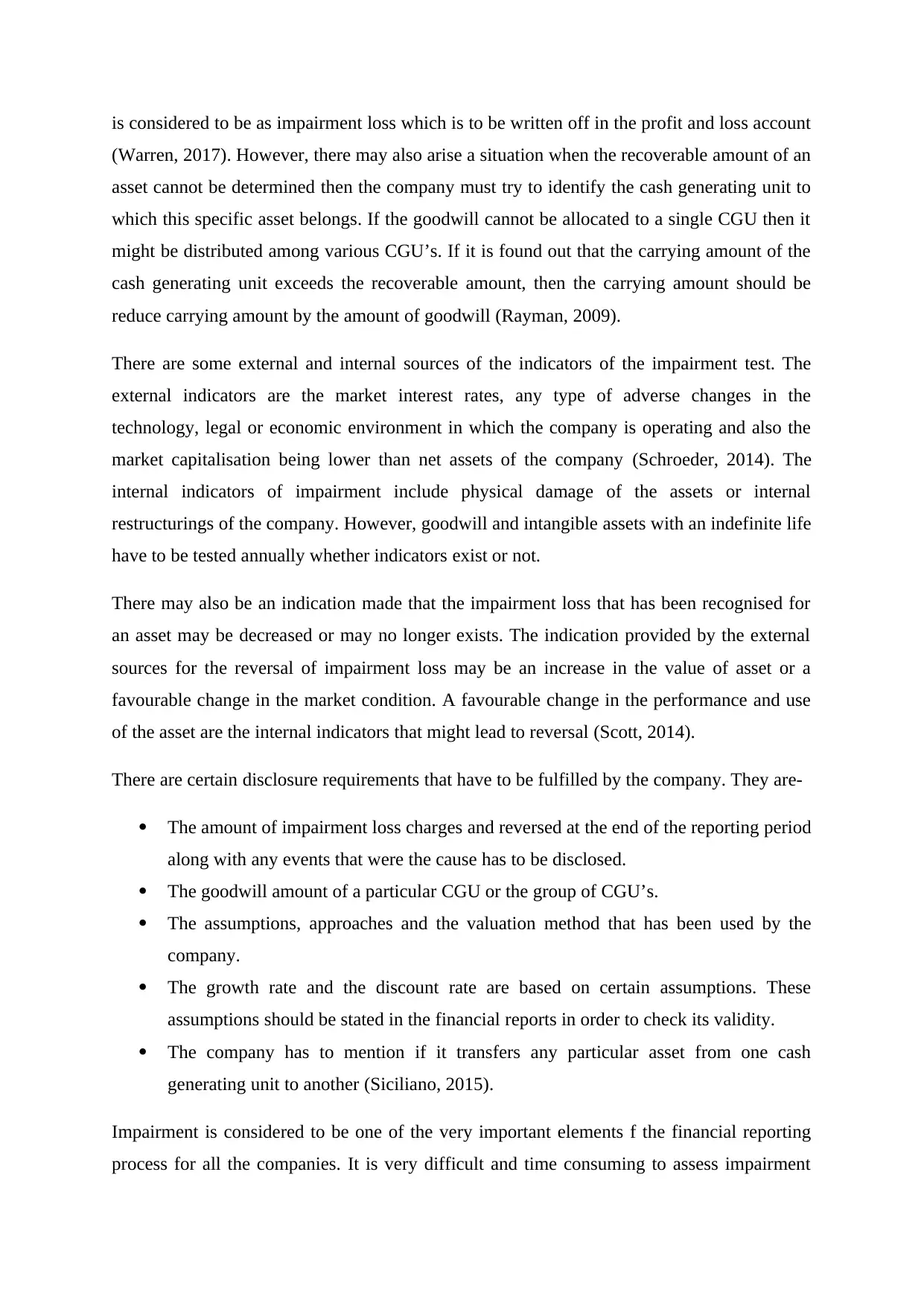
is considered to be as impairment loss which is to be written off in the profit and loss account
(Warren, 2017). However, there may also arise a situation when the recoverable amount of an
asset cannot be determined then the company must try to identify the cash generating unit to
which this specific asset belongs. If the goodwill cannot be allocated to a single CGU then it
might be distributed among various CGU’s. If it is found out that the carrying amount of the
cash generating unit exceeds the recoverable amount, then the carrying amount should be
reduce carrying amount by the amount of goodwill (Rayman, 2009).
There are some external and internal sources of the indicators of the impairment test. The
external indicators are the market interest rates, any type of adverse changes in the
technology, legal or economic environment in which the company is operating and also the
market capitalisation being lower than net assets of the company (Schroeder, 2014). The
internal indicators of impairment include physical damage of the assets or internal
restructurings of the company. However, goodwill and intangible assets with an indefinite life
have to be tested annually whether indicators exist or not.
There may also be an indication made that the impairment loss that has been recognised for
an asset may be decreased or may no longer exists. The indication provided by the external
sources for the reversal of impairment loss may be an increase in the value of asset or a
favourable change in the market condition. A favourable change in the performance and use
of the asset are the internal indicators that might lead to reversal (Scott, 2014).
There are certain disclosure requirements that have to be fulfilled by the company. They are-
The amount of impairment loss charges and reversed at the end of the reporting period
along with any events that were the cause has to be disclosed.
The goodwill amount of a particular CGU or the group of CGU’s.
The assumptions, approaches and the valuation method that has been used by the
company.
The growth rate and the discount rate are based on certain assumptions. These
assumptions should be stated in the financial reports in order to check its validity.
The company has to mention if it transfers any particular asset from one cash
generating unit to another (Siciliano, 2015).
Impairment is considered to be one of the very important elements f the financial reporting
process for all the companies. It is very difficult and time consuming to assess impairment
(Warren, 2017). However, there may also arise a situation when the recoverable amount of an
asset cannot be determined then the company must try to identify the cash generating unit to
which this specific asset belongs. If the goodwill cannot be allocated to a single CGU then it
might be distributed among various CGU’s. If it is found out that the carrying amount of the
cash generating unit exceeds the recoverable amount, then the carrying amount should be
reduce carrying amount by the amount of goodwill (Rayman, 2009).
There are some external and internal sources of the indicators of the impairment test. The
external indicators are the market interest rates, any type of adverse changes in the
technology, legal or economic environment in which the company is operating and also the
market capitalisation being lower than net assets of the company (Schroeder, 2014). The
internal indicators of impairment include physical damage of the assets or internal
restructurings of the company. However, goodwill and intangible assets with an indefinite life
have to be tested annually whether indicators exist or not.
There may also be an indication made that the impairment loss that has been recognised for
an asset may be decreased or may no longer exists. The indication provided by the external
sources for the reversal of impairment loss may be an increase in the value of asset or a
favourable change in the market condition. A favourable change in the performance and use
of the asset are the internal indicators that might lead to reversal (Scott, 2014).
There are certain disclosure requirements that have to be fulfilled by the company. They are-
The amount of impairment loss charges and reversed at the end of the reporting period
along with any events that were the cause has to be disclosed.
The goodwill amount of a particular CGU or the group of CGU’s.
The assumptions, approaches and the valuation method that has been used by the
company.
The growth rate and the discount rate are based on certain assumptions. These
assumptions should be stated in the financial reports in order to check its validity.
The company has to mention if it transfers any particular asset from one cash
generating unit to another (Siciliano, 2015).
Impairment is considered to be one of the very important elements f the financial reporting
process for all the companies. It is very difficult and time consuming to assess impairment
⊘ This is a preview!⊘
Do you want full access?
Subscribe today to unlock all pages.

Trusted by 1+ million students worldwide
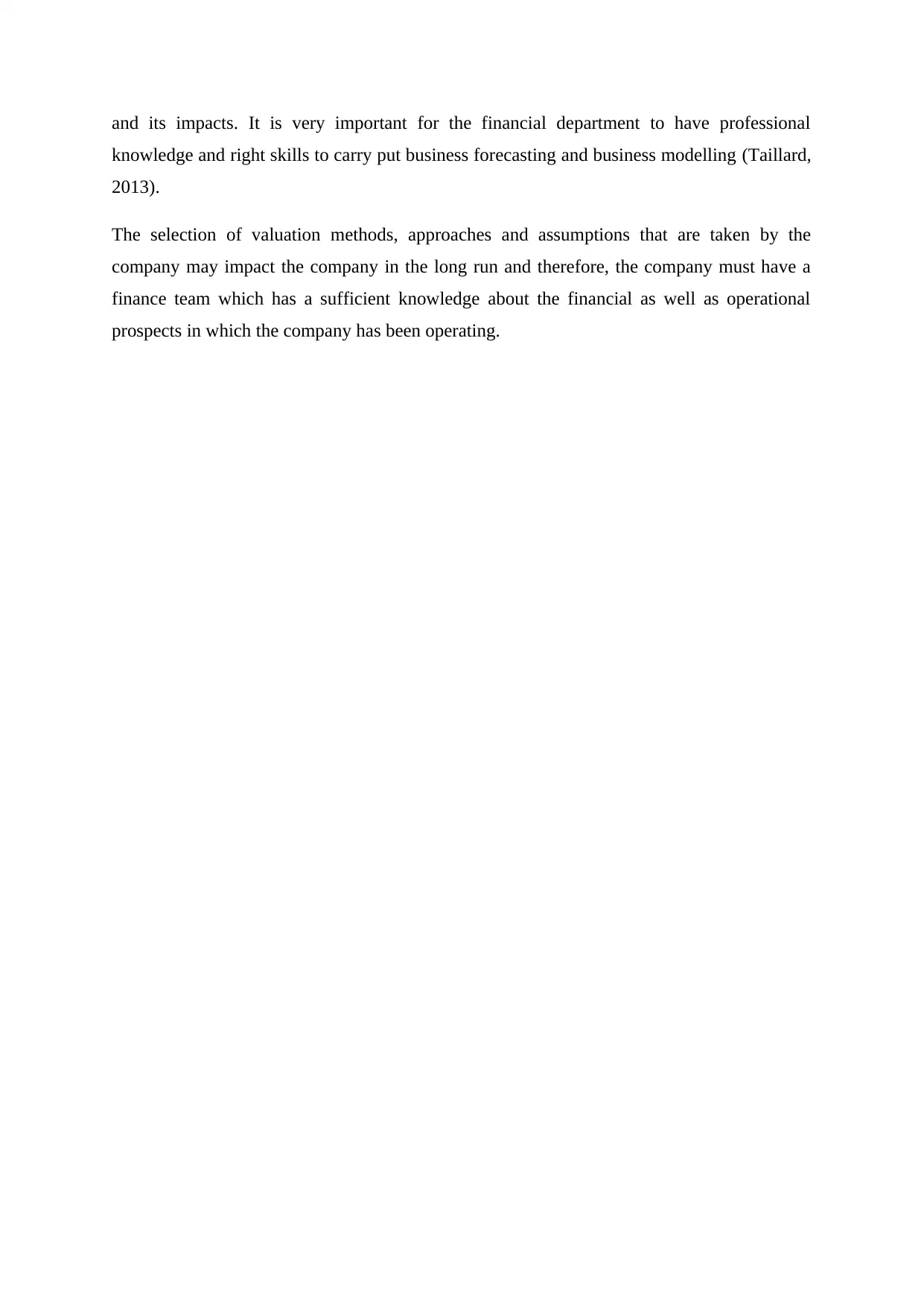
and its impacts. It is very important for the financial department to have professional
knowledge and right skills to carry put business forecasting and business modelling (Taillard,
2013).
The selection of valuation methods, approaches and assumptions that are taken by the
company may impact the company in the long run and therefore, the company must have a
finance team which has a sufficient knowledge about the financial as well as operational
prospects in which the company has been operating.
knowledge and right skills to carry put business forecasting and business modelling (Taillard,
2013).
The selection of valuation methods, approaches and assumptions that are taken by the
company may impact the company in the long run and therefore, the company must have a
finance team which has a sufficient knowledge about the financial as well as operational
prospects in which the company has been operating.
Paraphrase This Document
Need a fresh take? Get an instant paraphrase of this document with our AI Paraphraser
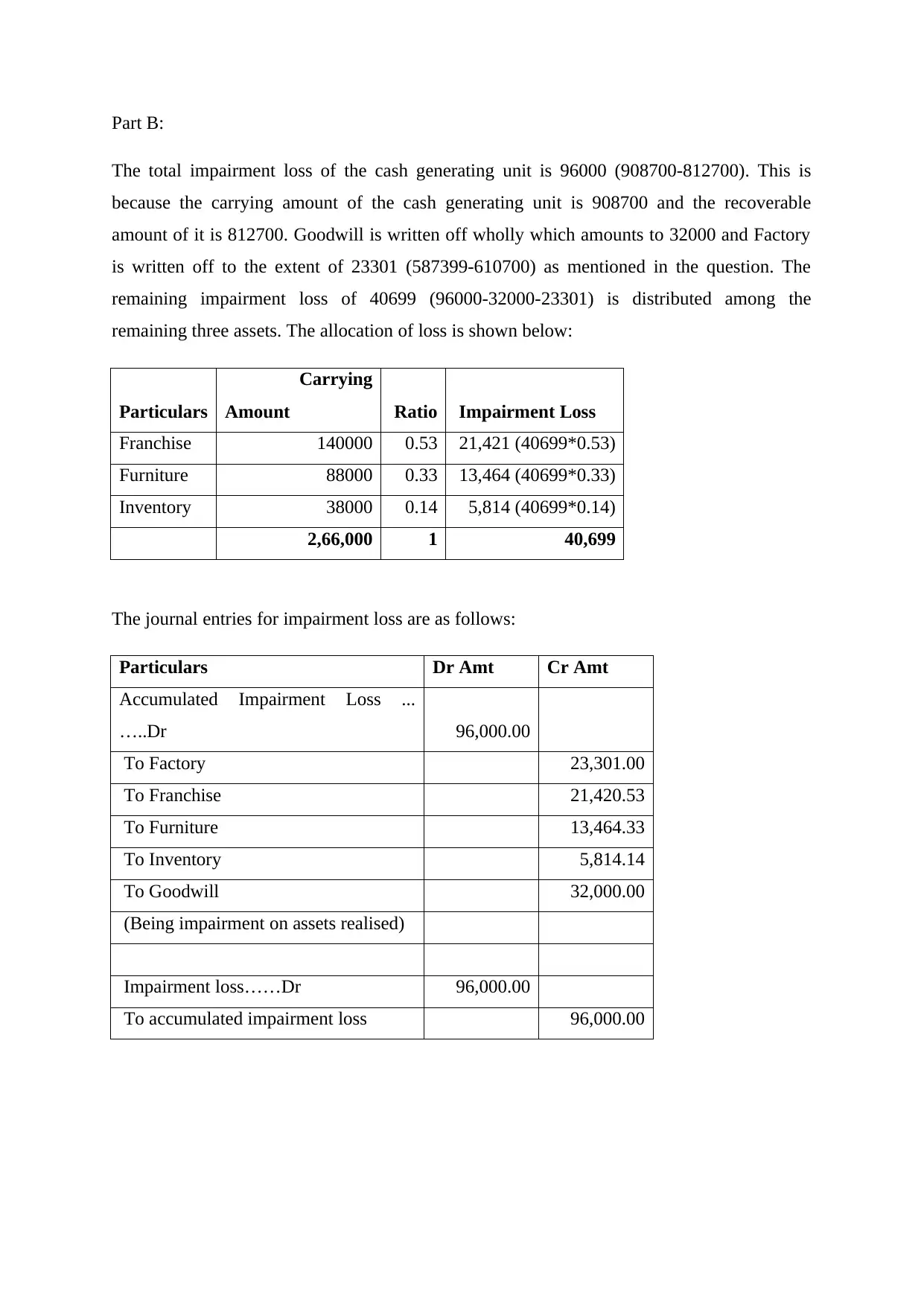
Part B:
The total impairment loss of the cash generating unit is 96000 (908700-812700). This is
because the carrying amount of the cash generating unit is 908700 and the recoverable
amount of it is 812700. Goodwill is written off wholly which amounts to 32000 and Factory
is written off to the extent of 23301 (587399-610700) as mentioned in the question. The
remaining impairment loss of 40699 (96000-32000-23301) is distributed among the
remaining three assets. The allocation of loss is shown below:
Particulars
Carrying
Amount Ratio Impairment Loss
Franchise 140000 0.53 21,421 (40699*0.53)
Furniture 88000 0.33 13,464 (40699*0.33)
Inventory 38000 0.14 5,814 (40699*0.14)
2,66,000 1 40,699
The journal entries for impairment loss are as follows:
Particulars Dr Amt Cr Amt
Accumulated Impairment Loss ...
…..Dr 96,000.00
To Factory 23,301.00
To Franchise 21,420.53
To Furniture 13,464.33
To Inventory 5,814.14
To Goodwill 32,000.00
(Being impairment on assets realised)
Impairment loss……Dr 96,000.00
To accumulated impairment loss 96,000.00
The total impairment loss of the cash generating unit is 96000 (908700-812700). This is
because the carrying amount of the cash generating unit is 908700 and the recoverable
amount of it is 812700. Goodwill is written off wholly which amounts to 32000 and Factory
is written off to the extent of 23301 (587399-610700) as mentioned in the question. The
remaining impairment loss of 40699 (96000-32000-23301) is distributed among the
remaining three assets. The allocation of loss is shown below:
Particulars
Carrying
Amount Ratio Impairment Loss
Franchise 140000 0.53 21,421 (40699*0.53)
Furniture 88000 0.33 13,464 (40699*0.33)
Inventory 38000 0.14 5,814 (40699*0.14)
2,66,000 1 40,699
The journal entries for impairment loss are as follows:
Particulars Dr Amt Cr Amt
Accumulated Impairment Loss ...
…..Dr 96,000.00
To Factory 23,301.00
To Franchise 21,420.53
To Furniture 13,464.33
To Inventory 5,814.14
To Goodwill 32,000.00
(Being impairment on assets realised)
Impairment loss……Dr 96,000.00
To accumulated impairment loss 96,000.00
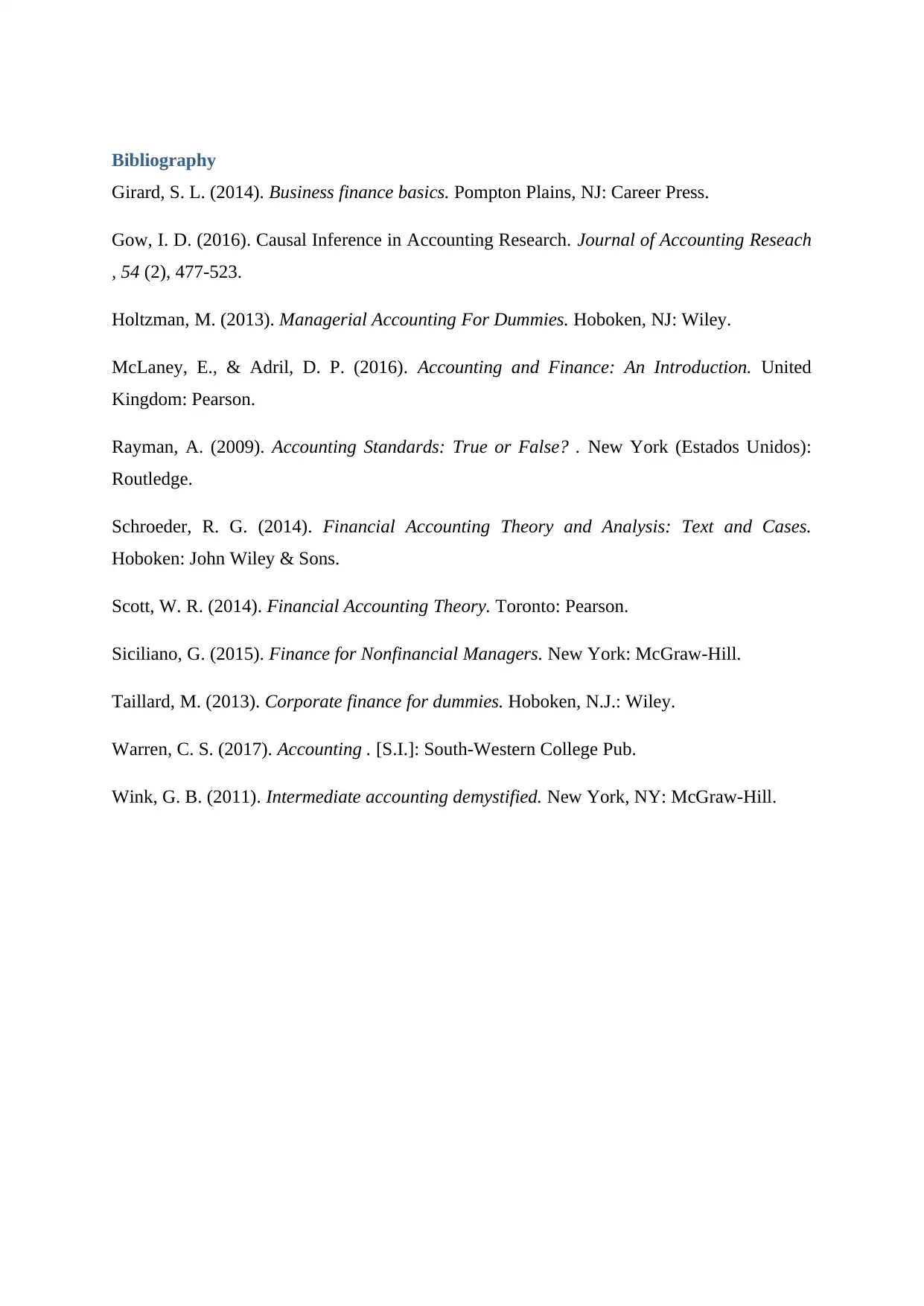
Bibliography
Girard, S. L. (2014). Business finance basics. Pompton Plains, NJ: Career Press.
Gow, I. D. (2016). Causal Inference in Accounting Research. Journal of Accounting Reseach
, 54 (2), 477-523.
Holtzman, M. (2013). Managerial Accounting For Dummies. Hoboken, NJ: Wiley.
McLaney, E., & Adril, D. P. (2016). Accounting and Finance: An Introduction. United
Kingdom: Pearson.
Rayman, A. (2009). Accounting Standards: True or False? . New York (Estados Unidos):
Routledge.
Schroeder, R. G. (2014). Financial Accounting Theory and Analysis: Text and Cases.
Hoboken: John Wiley & Sons.
Scott, W. R. (2014). Financial Accounting Theory. Toronto: Pearson.
Siciliano, G. (2015). Finance for Nonfinancial Managers. New York: McGraw-Hill.
Taillard, M. (2013). Corporate finance for dummies. Hoboken, N.J.: Wiley.
Warren, C. S. (2017). Accounting . [S.I.]: South-Western College Pub.
Wink, G. B. (2011). Intermediate accounting demystified. New York, NY: McGraw-Hill.
Girard, S. L. (2014). Business finance basics. Pompton Plains, NJ: Career Press.
Gow, I. D. (2016). Causal Inference in Accounting Research. Journal of Accounting Reseach
, 54 (2), 477-523.
Holtzman, M. (2013). Managerial Accounting For Dummies. Hoboken, NJ: Wiley.
McLaney, E., & Adril, D. P. (2016). Accounting and Finance: An Introduction. United
Kingdom: Pearson.
Rayman, A. (2009). Accounting Standards: True or False? . New York (Estados Unidos):
Routledge.
Schroeder, R. G. (2014). Financial Accounting Theory and Analysis: Text and Cases.
Hoboken: John Wiley & Sons.
Scott, W. R. (2014). Financial Accounting Theory. Toronto: Pearson.
Siciliano, G. (2015). Finance for Nonfinancial Managers. New York: McGraw-Hill.
Taillard, M. (2013). Corporate finance for dummies. Hoboken, N.J.: Wiley.
Warren, C. S. (2017). Accounting . [S.I.]: South-Western College Pub.
Wink, G. B. (2011). Intermediate accounting demystified. New York, NY: McGraw-Hill.
⊘ This is a preview!⊘
Do you want full access?
Subscribe today to unlock all pages.

Trusted by 1+ million students worldwide
1 out of 6
Related Documents
Your All-in-One AI-Powered Toolkit for Academic Success.
+13062052269
info@desklib.com
Available 24*7 on WhatsApp / Email
![[object Object]](/_next/static/media/star-bottom.7253800d.svg)
Unlock your academic potential
Copyright © 2020–2025 A2Z Services. All Rights Reserved. Developed and managed by ZUCOL.




